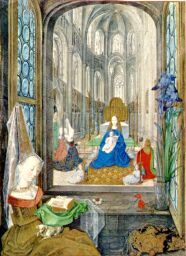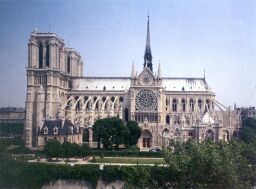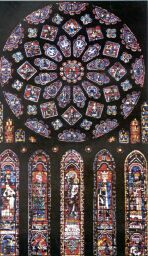|







 

III Illuminating Love

Chaucer: Troilus and
Criseyde

Medieval Lyrics

Innocent III: On Misery

Saint Augustine:
Confessions

Capellanus: The Art of
Courtly Love

Augustine's Fruit

Chaucer:
Troilus and Criseyde (original)

Engaging Chaucer
Our subject has one focus: the course of love.
What makes love compelling?
After reading, pick one passage that shows
how lovers act at a particular time and place,
in a particular stage of their encounters.
Chaucer’s essential
focus is on what contributes
to the joy Troilus and Criseyde anticipate and
eventually enjoy. Attentive readers will work to see
through their eyes, their senses, their assumptions
and expectations, their desires.
This is no little
thing for me to say;
It stuns imagination to express.
For each began to honour and obey
The other’s pleasure; happiness, I guess,
So praised by learned men, is something less.
This joy may not be written down in ink,
For it surpasses all that heart can think.
(III,242, p 171)
After appreciating the
fruits of love you may of course
consider the costs. Pandar, as well as Criseyede and Troilus, are initially wary of love.
And Love’s old sweet song ends unhappily, as court ladies daily hear
from fashionable singers. None-the-less all three at times agree
with Chaucer’s condemnation of nay-sayers.
Lord! Do you think
some avaricious ape
Who girds at love and scorns it as a toy,
Out of the pence that he can hoard and scrape,
Had ever such a moment of pure joy
As love can give, pursuing his foul ploy?
Never believe it! For, by God above,
No miser ever knew the joy of love.
(III, 195, p 159)
Misers would answer
‘Yes,’; but, Lord, they’re liars!
Busy and apprehensive, old and cold
And sad, who think of love as crazed desires;
But it shall happen to them as I told;
They shall forgo their silver and their gold
And live in grief; God grant they don’t recover,
And God advance the truth of every lover!
(III, 196, p 159)
I wish to God those
wretches that dismiss
Love and its service sprouted ears as long
As Midas did, that man of avarice;
Would they were given drink as hot and strong
As Crassus swallowed, being in the wrong,
To teach such folk that avarice is vicious
And love is virtue, which they think pernicious.
(III, 197, p 160)
Chaucer’s World
After
centuries of patriarchal concerns with war and honor, medieval women
take center stage, and love flourishes in song (troubadours), in verse
and prose
(The Divine Comedy and The Decameron
as well as Troilus and Criseyde), in letters (Heloise and Abelard).
Consider Mary of Burgundy and the world she imagines thorough reading in
her book of Hours:
Reading Mary of
Burgundy

Consider six changes
from Greek culture which contribute to such new habits of attention.
A. Monotheistic belief
now assumes a creator who moves creatures through desire.
Among the most powerful of desires are sexual and familial love.
Love makes the world go ’round.
B. This world prepares
souls for life after death, for some in heaven, for some in hell.
The exercise of desire in this life establishes not just the direction
of life after death,
but more the development of character which will flourish or seethe in
heaven or in hell.
C. Since every soul is
unique, and the actions of every individual will lead
to heaven or to hell, the study of the psyche, psychology, takes
precedence.
Character no longer arises from the pursuit of excellence, from earned
pride.
Character takes shape from the company one keeps, from the practice of
love.
D. Pleasure and pain
are pointers to heaven and hell. To recollect
personal experiences of intense pleasure is to shape directions to
future bliss,
to salvation. To recollect personal experiences of pain is to shape
directions
away from future suffering, from damnation. Fearful isolation
characterizes damnation.
Cooperative company characterizes salvation.
E. Conversion,
re-orientation, changes not just what we see and do,
but how we see and act. Conversions may arise from the discovery of
generative patterns
in astronomy, in mathematics, in music (the medieval trivium).
Conversions may appear
in the discovery of a religious calling. But conversion most commonly
appears
when individuals fall in love.
E. Scripture directs
attention and focuses desire. The speaking soul anticipates,
discovers and actualizes the language of love. In the beginning was the
word . . .
Medieval Love
Lyrics
Chaucer identifies himself, not as a lover, but as a student of
love. He works to trace the sensations, the feelings and thoughts, the
language and actions of specific lovers as they unfold in specific
places at specific times. As an author, he stimulates us to
participation in the lover’s world, a necessary prerequisite if informed
judgments are to follow. Observation of actual experience, not just the
empty exercise of presuppositions, feeds recollection and recognition.
Consider the evidence of natural desire,
working just before dawn (at matins), equally apparent
in wildlife and in people
—
I have a gentil cock
I have a gentil cock,
Croweth me the day;
He doth me risen erly,
My matins for to say.
I have a gentil cock;
Comen he is of gret:
His comb is of red coral,
His tayil is of jet.
I have a gentil cock;
Comen he is of kynde;
His comb is of red coral,
His tayil is of Inde.
His legges been of
asor,
So gentil and so smale;
His spures arn of silver-whyt
Into the wortewale.
His eyen arn of
crystal,
Looking all in aumber;
And every nyght he percheth him
In myn lady’s chaumber.
The splendor of nature
appears through the rooster’s shape, coloration, gestures and voice. A
lover would himself perch in his lady’s chamber. Sexual passion
surely inspires this voice. The plumage, gestures,
voice and actions of birds draw attention to the
richness and energy of creation.
Consider now the
appearance of a mother at sunset.
Her shape, coloration, gestures and voice also demonstrate natural
passion. As the sun sets
(at vespers), as darkness grows, as chill spreads,
her memories pierce and fade —
Nu goth Sonne
Nu goth Sonne under
wode.
Me rueth, Mary, thy faire rode.
Nu goth Sonne under tree.
Me rueth, Mary, thy Sone and thee.
Now goes the sun below trees
I pity, Mary, thy faire face.
Now goes the sun (Son) under tree (cross).
I pity, Mary, thy son and thee.
Mary, of course,
recalls her son’s crucifixion. Her recollection, however, springs from
the natural events, so common but so potentially affecting, she senses
and inhabits. If spring and dawn evoke the promise of birth, of new
life, of beginnings, autumn recalls sufferings attending age,
experiences of mortality, endings. The observer, however, is not just
Mary, but also the speaker, who sorrows with Mary, not by understanding
her feelings, but by inhabiting her circumstances. Passion originates
with suffering (recall the Valentine convention, a heart pierced with
Cupid’s arrow), the heart contracts, and compassion with a fellow
sufferer follows.
Complementary
associations and desires arise
in the appearance of flourishing girl —
Stetit Puella
There stood the girl
In the crimson dress
At the softest press,
How that tunic rustled:
Eia!
There stood the girl,
Rosebud on a vine;
Face ashine,
Mouth a reddish bloom.
Eia!
Slender, lithe, dressed to impress, she invites, deserves and receives
attention. Appreciative observers, drawn by the blush animating her
mobile, expressive face, trace her attitudes, gestures, approaches,
anticipating closer acquaintance. Eyes may be windows of the soul,
widening, glistening when aroused in anticipation.
Here lips invite carnal knowledge, attracting through texture, through
gesture. Her lips invite not just
a momentary bliss, but further acquaintance with
the language of love.
Medieval observers
would recall a parallel scene,
the Stabat Mater, where Mary stood suffering as a lance pierced her
crucified son’s heart. Stetit Puella would replace such attentions with
current attractions.
But experiences of carnal passion and experiences
of familial compassion are related, facing pages
of common, essential experience.
Mary, of course, is an
exceptional, a matchless mother. Medieval approaches to her, however,
emphasize circumstances evident in many mothers. The recognition
of pregnancy engenders appropriate surprise. Mary’s exceptional
situation develops from the commonest
of the evidences of love: the desire of a mother for fruitful life, her
desire for her child’s happiness, her awareness
of inevitable pain —
I singe of a Maiden
I singe of a Maiden
That is makeless;
King of all kinges
To her Sone she ches.
He cam all so stille
Ther his Moder was,
As dew in Aperille
That falleth on the grass.
He cam all so stille
To his Modres bour,
As dew in Aperille
That falleth on the flour.
He cam all so stille
Ther his Moder lay,
As dew in Aperille
That falleth on the spray.
Moder and maiden
Was nevere non but she.
Well may swich a lady
Goddes Moder be.
This song assumes, of
course, listeners with shared religious beliefs. But the power of the
song grows
from the most natural of circumstances, the real appearance of dew
droplets, minute opalescent, omnipresent and illuminating nourishment.
Dew sustains equally the smallest blade of grass, the grandest oak,
the field mouse and the emperor. The archangel Gabriel appears to Mary,
announcing the conception of Christ.
But we may take equal energy not just from rituals including such as
baptism, but from the commonest
of sights available on any early spring morning.
Love makes the world go ’round.
Medieval Lyrics

Loves old sweet
song
Medieval troubadours
(perhaps in need of sustenance
in foreign lands) developed and practiced the language
of courtly love. Some might recall the joys of creation
in the accurate mimicking of springtime bird calls
(rou coucou for doves, cock-a-doodle-do for English roosters,
ri-ki-ki-ki for German roosters). Bird calls
might delight even more those who also recognized astonishingly complex
rhymes supporting such calls
as well as celestial and terrestrial geometries.
One song of courtly
love, In a garden under a hawthorn bower, demonstrates the appeal of
love to watchers,
well aware of love’s limits, but moved by apparent bliss. Aubades, dawn
songs, reappear in every age. If vespers, the time for evening
meditations, invite reconsideration
of daylight activities, dawn may serve as the time for renewed
engagements. But lovers prefer night.
Enclosed in a bower, out of sight and mind from public scrutiny, lovers
can escape the restrictions of judgment
to explore unconditional passion, to seek
their mutual bliss.
In a garden under a hawthorn bower
In a garden under a
hawthorn bower
A lover to his lady’s closely drawn
Until a watchman shouts the mourning hour.
O God! O God! how swift it comes—the dawn!
“Dear God, if this
night would never fail
And my lover never far from me was gone,
And the watchman never saw the morning pale
But, O my God! how swift it comes—the dawn!”
“Come, pretty boy,
give me a little kiss
Down in the meadow where birds sing endless song.
Forget my husband! Think—just think of this—
For, O my God! how swift it comes—the dawn!”
“Hurry, my boy. The
new games end at morn.
Down to that garden—those birds—that song!
Play, play till the crier blows his horn,
For, O my God! how swift it comes—the dawn!”
“Down in the sweet air
over the meadow hovering
I drank a sweet draught—long, so long—
Out of the air of my handsome, noble lover.
O God! O God! how swift it comes—the dawn!”
The lady’s pretty. She
has many charms.
Toward her beauty many men are drawn.
But she lies happy in one pair of arms.
O God! O God! how swift it comes—the dawn!
The lady, older and
more experienced than her lover, appreciates full well the disapproval
of outsiders,
of those who would curtail her passions. She directs
her younger lover at night to a bower where all blossoms, where birds
sing endless songs. In such a place
lovers freed from pressing duties may discover the bliss
of mutually engaging desires. As each seeks the other’s bliss, that
chain-reaction which fuels ecstasy unfolds, blossoms.
Her encouragement
contains, of course, the wisdom
of experience: “O God! O God! How swift it comes—
the dawn.” But she will seek out with her lover circumstances in which
such concerns will fade,
in which unconstrained desires may flourish. The experiences she seeks
and offers will not endure.
To attend to such limitations, however, will block
the experiences, however momentary, she senses
as living, experiences different in kind from
the reasonable calculations of duty.
The watchman, of
course, signals a return to reason
and civility. But those who hear this lady’s song,
even while sharing the watchman’s judgment,
may also cling for a moment to desire. Before
a possible resurrection, we may seek fulfillment
here and now:
This is no little
thing for me to say;
It stuns imagination to express.
For each began to honour and obey
The other’s pleasure; happiness, I guess,
So praised by learned men, is something less.
This joy may not be written down in ink,
For it surpasses all that heart can think.
(III,242, p 171)
Criseyde (and Troilus)
come to share the troubadour’s expressions of desire. The wisdom of
experience will find voice: “O God! O God! How swift it comes—the dawn.”
But Criseyde and Troilus will none-the-less seek out circumstances in
which such concerns fade, in which unconstrained desires flourish. Their
experiences,
love’s old sweet song, will not endure. Attending too early to such
limitations, however, blocks experience of love which offer the highest
sense of being alive. Later,
perhaps, we may return to the reasonable
calculations of duty.
Watchman, of course,
signal a return to reason and civility. But those who hear the
cautionary reassurance of civility, recalling then the song of love, may
cling for some moments to desire. Before a possible resurrection,
we may seek fulfillment here and now:
O God! O God! how
swift it comes—the dawn!


Mary Builds Chartres

Mary's blue robe, a
relic brought to Chartres in France by crusaders returning from
Jerusalem, mirrors the celestial blue sky surrounding her in heaven.
Sunlight radiates from each. Suppliants before her robe, like
suppliants looking up to the blue cloak of heavens, seek her presence,
her light. Miracles follow.
When fire destroyed
her Romanesque church in 1194, stone crumbled, metal melted, but her
robe survived intact. Her message: build a suitable home. The present Chartres Cathedral, consecrated in 1260, established the structures and
energies which would populate Europe with Notre Dames, unprecedented
communal centers,
all arising within a few score years. Pointed, ribbed vaulting
buttressed outside enabled vertical heights unimagined previously, with
openings for light-radiating rose windows, with lancet windows opening
out lancet walls, illuminating
Mary’s virtues.
Wide participation
in the construction brought together communities,
kings and commoners, men and women, elders and youth. Stories abound.
Kings and commoners side-by-side pull stone-carts to rising walls.
Ben Shahn invites continuing participation —
. . . an
itinerant wanderer traveling over country roads in thirteenth-century
France who comes across a man exhaustedly pushing a wheelbarrow full
of rubble. He asks what the man is doing. ‘God only knows. I push
these damn stones around from sunup to sundown, and in return, they
pay me barely enough to keep a roof over my head.’
“Farther down the
road, the traveler meets another man, just as exhausted, pushing
another filled barrow. In reply to the same question, the second man
says, ‘I was out of work for a long time. My wife and children were
starving. Now I have this. It’s killing, but I’m grateful for it all
the same.”
“Just before
nightfall, the traveler meets a third exploited stone-hauler. When
asked what he is doing, the fellow replies, ‘I’m building Chartres
Cathedral.’”
Within one-hundred
years Notre Dame spreads through the power of Mary gothic structures and
gothic practices throughout Europe.

Mary Brings Light
Those seeking Mary’s
intercession at Chartres literally stand in heavenly light. Every hour
of every day varies Mary’s presence: circumstances
─
weather, politics,
economics, moods ─
shift and flow. Life
generating sunlight, infinitely inflected with Mary‘s intercessions,
move each and every suppliant. At vespers (evening), approaching the
Western portal, the setting sun animates the judgment day arching the
doorway, anticipating two approaching worlds, the illuminations of
heaven, the shadings of hell. Within, eastward, altar candles anticipate
morning sunrise. At transept, northern exposure offsets temperate South
rose, realizing under the protective wall the temperate garden which
shelters all creatures.
What drives such
activity? Not, presumably, the technical discovery of vaulting, flying
buttresses, illuminated glass. More, the spirit of Mary, a
new influence manifesting new circumstances and desires throughout
Europe in the 12th century.

The Art of Courtly Love
In 1137, Eleanor
succeeded her father William X, as ruler of Aquitane, and married (by
prearrangement of her father) Louis VII of France. She joined Louis on
the second crusade, and exercised considerable influence in arts as well
as politics at Champagne. At Poitiers, she established courtly life and
manners praised by troubadours of the time. Her daughter Marie, Countess
of Champagne, inspired The Art of Courtly Love (Liber de arte honeste
amandi et reprobatione inhonesti amoris), written about 1185 by her
chaplain André. Divorced from Louis in 1152, she married Henry
Plantagenet, 12 years her junior. Her children by both marriages came to
occupy a significant portion of European thrones. Chaucer’s Troilus
and Criseyde assumes the conventions and psychology implicit in the
art
of courtly love.
Capellanus' Art of Courtly
Love

St. Augustine's Revisions
Chaucer's sympathy
for Troilus and Criseyde does not limit his recognition of limitations
attending earthly desires. Pope Innocent focuses our attention on the
costs of seeking satisfaction through the exercise of mortal desires.
Chaucer's counterpart in engaging readers in psychological analysis of
desire, however, is St Augustine. His confessions redirect his desires
to more lasting objects.
Pope Innocent on
Misery

Augustine's Stolen
Fruit

Augustine's Vision


 |